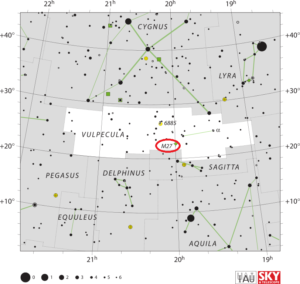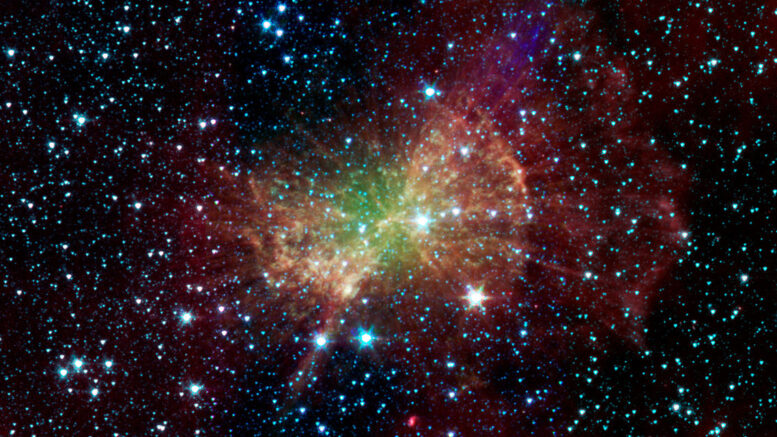Spotted by Charles Messier in 1764, the Dumbbell Nebula (Messier 27) was the first planetary nebula ever discovered. With the planet-like appearance through a small telescope, it would seem that this is a bit of a misnomer to call it a “planetary nebula.” However, it is worth noting that the nebula is the result of an old star that has shed its outer layers in a glowing display of color. The central star in the Dumbbell Nebula is a white dwarf with with a visual magnitude of 13.5 and a radius of 0.055 solar radii, which makes the star the largest white dwarf known.
The name Dumbbell comes from the English astronomer John Herschel, who observed the nebula in 1828 and compared its shape to that of a dumbbell. Messier 27 is the second brightest planetary nebula in the sky, second only to the Helix Nebula in Aquarius.
| Description | |
| Visible From Pacific Northwest | May Through October |
| Best Time To Observe | August and September |
| Minimum Size Of Viewing Device | Small Telescope |
| Object Type | Planetary Nebula |
| Designations | Messier 27, M27, Dumbbell Nebula, Apple Core Nebula, Diabolo Nebula, NGC 6853, Hen 2-452, BD+22 3878, CSI+22-19572, EUVE J1959+22.7, WD 1957+225, PN VV 246, PN ARO 14, PN VV’ 521, PK 060-03, RX J1959.6+2243, GCRV 12336, GC 4532, h 2060 |
| Right Ascension | 19h 59m 36.340s |
| Declination | +22°43’16.09” |
| Constellation | Vulpecula |
| Absolute magnitude | -0.6 |
| Apparent magnitude | 7.5 |
| Apparent dimensions | 8′ x 5′.6 |
| Object Radius | 1.44 light years |
| Distance From Earth | 1,360 light years |
History
Messier 27 was the first ever planetary nebula to be discovered. Charles Messier found it on July 12, 1764 and described it as a “nebula without star” that “appears of oval shape.” In the first Messier catalogue (1771), he wrote:
On July 12, 1764, I have worked on the research of the nebulae, and I have discovered one in the constellation Vulpecula, between the two forepaws, & very near the star of fifth magnitude, the fourteenth of that constellation, according to the catalog of Flamsteed: One sees it well in an ordinary refractor of three feet & a half [FL]. I have examined it with a Gregorian telescope which magnified 104 times: it appears in an oval shape; it doesn’t contain any star; its diameter is about 4 minutes of arc. I have compared that nebula with the neighboring star which I have mentioned above [14 Vul]; its right ascension has been concluded at 297d 21′ 41″, & its declination 22d 4′ 0″ north.
The name Dumbbell comes from the English astronomer John Herschel, who observed the nebula in 1828 and compared its shape to that of a dumbbell.
Locating M27 In The Sky
The nebula lies about a quarter of the way from Altair to Deneb. Aquila and Cygnus are easy to make out in the night sky because the two bird constellations, representing the Eagle and the Swan, are high overhead in the summer and lie opposite to each other. Cygnus is particularly prominent and easy to identify because its brightest stars form the Northern Cross, another familiar summer asterism.

Viewing M27
Visually, the Dumbbell Nebula appears white even in larger telescopes, but its two-lobed shape is clear. It can be seen in large binoculars, and some of its details are visible even in smaller telescopes.
Photographing M27
Using color astrophotography, one can reveal the nebula detail. The Dumbbell Nebula is a very popular target for astrophotographers, so there are a plethora of options in terms of guides to follow for your own imaging. The key here is the the target does not require several hours to get great results, as about 90 minutes worth of photography using 6 minute exposures can do the trick. The use of filters, specifically Narrowband filters, can help reveal the outer structure. Both CMOS and DSLRs (unmodified and modified DLSRs) can be used to capture beautiful images of M27.
Sources And Further Reading
Descriptions of all of Messier Objects can be found here.
https://www.nasa.gov/feature/goddard/2017/messier-27-the-dumbbell-nebula
https://www.messier.seds.org/m/m027.html
https://www.galactic-hunter.com/post/m27-the-dumbbell-nebula

Leave a comment